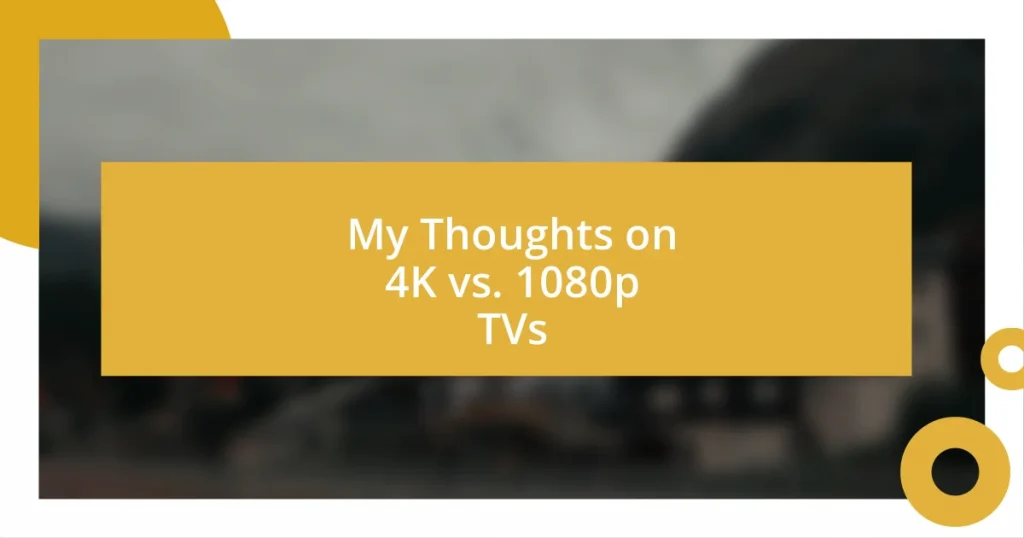Key takeaways:
- 4K TVs offer a significantly higher resolution (3840 x 2160) than 1080p TVs (1920 x 1080), resulting in greater detail and a more immersive viewing experience.
- While 4K provides superior image quality and enhanced gaming experiences, 1080p TVs are more affordable, lightweight, and compatible with a wide range of content.
- Choosing between 4K and 1080p depends on personal viewing habits and content availability, as emotional connections with shows can often outweigh the importance of resolution.

Understanding 4K and 1080p TVs
When I first encountered 4K TVs, I couldn’t help but marvel at the crispness of every image. The difference between 1080p and 4K is staggering. With 4K, you’re looking at a resolution of 3840 x 2160 pixels—four times that of 1080p (which has a resolution of 1920 x 1080). This leap in pixel count means more detail, more depth, and a vividness that can truly transform your viewing experience.
I remember watching my favorite nature documentary in 4K, and it felt almost like I was there, standing on the edge of a cliff overlooking a sprawling valley. The colors were so vibrant and lifelike that I could almost feel the cool breeze against my skin. It made me question how much of a difference detail and resolution really make in our everyday lives—do we truly appreciate it until we experience it firsthand?
However, it’s essential to recognize that not every content we consume is available in 4K yet. While streaming services are increasingly offering 4K options, I often find myself pondering whether the investment in a 4K TV is worth it if my favorite shows are still in 1080p. Yet, when that cinematic moment comes where everything aligns in stunning 4K, it seems to justify the upgrade completely.

Key Differences in Resolution
The key differences in resolution between 4K and 1080p TVs are fundamental to the viewing experience. The sheer pixel density of 4K screens provides an astonishing level of detail that may not be as prominent in 1080p. When I first viewed my favorite action movie in 4K, the richness of the imagery made me feel as if I were part of the scene—the explosions, the textures, and the colors popped in ways I had never seen before. I remember thinking, “Was that always there, or is it just revealing itself now?”
- Resolution: 4K has a resolution of 3840 x 2160 pixels, while 1080p is 1920 x 1080 pixels.
- Pixel Count: 4K offers four times the number of pixels compared to 1080p, resulting in crisper images.
- Detail and Clarity: With more pixels, 4K content displays finer detail, especially on larger screens or when viewed up close.
- Viewing Experience: 4K provides a more immersive experience, making viewers feel as though they are part of the story.
I often find myself encouraging friends to opt for 4K, especially if they’re investing in a new television. When my buddy finally upgraded, I joined him for a movie night. As we sat there, I saw his eyes widen when he remarked on how lifelike the visuals were, even for seemingly ordinary scenes. It was in that moment I realized the power of enhanced resolution—not just in numbers, but in the emotional connection we form with what we watch.

Benefits of 4K TVs
I can’t stress enough how stunning the image quality on a 4K TV can be. The increased resolution allows for a broader color spectrum and enhanced contrast, making darker scenes visually richer. I remember watching a thrilling sci-fi series where shadows defined the story. In 4K, I could see intricate details, like the subtle textures of the characters’ costumes, which added layers to the narrative that I had overlooked before. It’s fascinating how much more engaging a show can be when you can almost feel the ambiance through your screen.
When it comes to gaming, 4K TVs change the game—literally. As an avid gamer, I often indulge in the latest titles that support 4K gameplay. The smoothness and clarity can be breathtaking. I recall a particular evening spent playing an open-world adventure. The landscapes—towering mountains, reflective lakes, and bustling cities—were not just backgrounds; they became immersive worlds to explore. Playing in such detail made every quest feel more intense and rewarding. For gamers or movie buffs alike, that extra level of immersion is not just a bonus; it elevates the entire experience.
On top of the image quality, let’s not forget about upscaling technology, which many 4K TVs now boast. This feature enhances lower-resolution content to near-4K quality. I have a collection of classic films that, while they originally aired in lower resolutions, look surprisingly refreshed and detailed on my 4K TV. It’s a delightful surprise that makes revisiting favorites more enjoyable, showing me that I can enjoy my old treasures in a brand new light.
| Feature | 4K TVs |
|---|---|
| Image Quality | Superior detail and color accuracy |
| Gaming Experience | Enhanced visuals and immersion |
| Upscaling Capacity | Improves lower-resolution content |

Advantages of 1080p TVs
The charm of 1080p TVs lies in their accessibility and affordability. I still remember my first experience setting up my own home theater system. A 1080p TV was perfect for my budget, and I was amazed at how great movies looked on it, even without the extra pixels. It allowed me the joy of hosting friends for movie nights without breaking the bank—something I think many can relate to when starting their TV journey.
One thing I appreciate about 1080p TVs is their compatibility with a wide range of content. I often find myself revisiting classic films or even older TV shows that were produced in 1080p. Each rewatch brings back fond memories, and it makes me wonder how connected we become to our favorite series through mere pixels. Wouldn’t you agree that the stories themselves often resonate even more than the resolution?
Another advantage of 1080p TVs is their light weight and lower energy consumption compared to 4K models. I remember moving my 1080p TV with ease from room to room while redecorating my space. It was a simple task that reminded me of how practical these TVs can be for everyday life. Plus, the savings on energy bills adds a nice touch—something we can all appreciate in these times of rising costs.

Impact of Content on Quality
The type of content you watch really makes a difference in perceived quality. I’ve noticed that streaming services often offer different resolutions for the same show. When I’m binge-watching a favorite series, I can feel the impact of the resolution change; a show produced in 4K feels vibrant and alive, while one originally aired in 1080p can sometimes seem flat. Have you felt that difference while watching something you love? It’s like experiencing the warmth of a well-lit room versus a dimly lit space.
When I dive into documentaries or nature shows, 4K content genuinely shines. The stunning visuals—think sweeping vistas or up-close wildlife—become more captivating and remind me of being outside. Just the other weekend, I watched a breathtaking documentary on coral reefs in 4K. The details felt so real that I almost believed I could reach out and touch the vibrant corals. It’s moments like these that illustrate how specific content can elevate the viewing experience.
However, not all content is created equal. Sometimes, I find myself watching older sitcoms that were shot in standard definition; the charm lies in the writing and performances, not the pixels. I remember laughing at an old episode of Friends, where the storyline pulled me in so deeply that I didn’t even notice the grainy quality. It made me realize that while resolution matters, the emotional connections we forge with our favorite shows often transcend visual clarity. Wouldn’t you agree that storytelling sometimes takes the front seat, even when the quality dips?

Conclusion on TV Resolution Choices
Choosing between 4K and 1080p TVs ultimately boils down to personal preference and viewing habits. I vividly recall standing in front of the TV display at my local electronics store, dazzled by the vibrant colors of the 4K models. However, as I stepped back and took a moment to consider my usual viewing, I realized that many of my go-to shows were in 1080p. It led me to question: do I really need all those extra pixels if I’m not even utilizing them?
When it comes to practicality, I think about how I use my TV daily. I love hosting game nights with friends, and while a 4K TV would certainly impress, the 1080p model I currently own has served me well. I remember a night filled with laughter over a multiplayer game; the quality was more than sufficient for us to enjoy ourselves fully. This experience made me ponder—the difference in resolution may not matter as much in a lively environment where connection and fun take center stage.
In the grand scheme, I believe there’s room for both resolutions in our homes. Sometimes, I catch myself daydreaming about expanding my setup, possibly getting a 4K screen for those special movie nights or nature docs. After all, watching a beautifully rendered film in 4K can be a cinematic experience unlike any other. Yet, my old faithful 1080p TV will always hold a special place in my heart, serving as a constant reminder of shared moments and cozy evenings spent together. Isn’t that what truly makes a television valuable?















